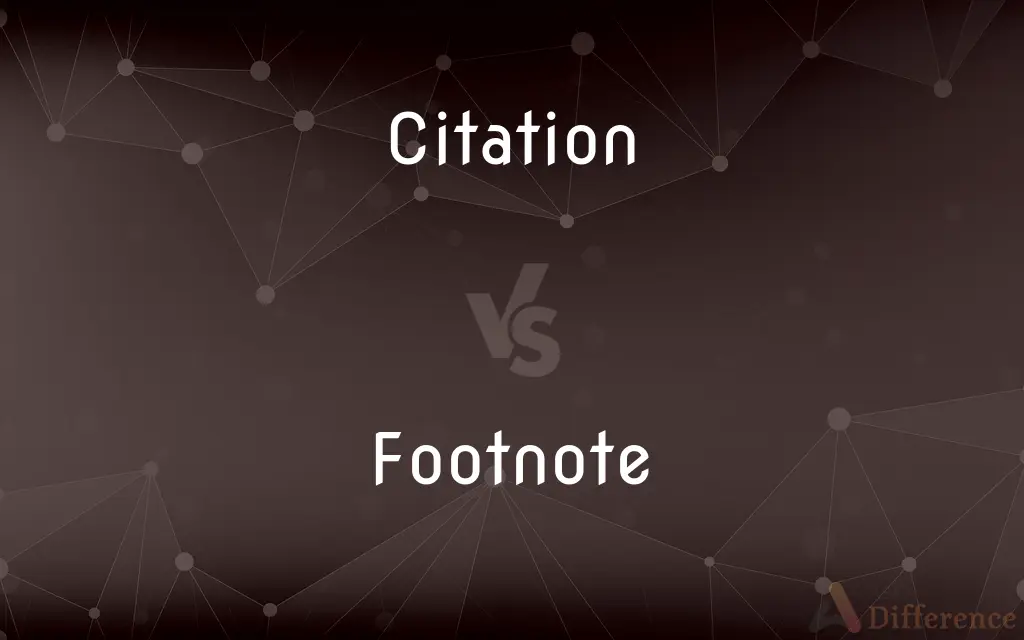Citation vs. Footnote — What's the Difference?
By Urooj Arif & Fiza Rafique — Updated on March 19, 2024
A citation provides source information within the text, while a footnote offers additional information or comments at the page's bottom.

Difference Between Citation and Footnote
Table of Contents
ADVERTISEMENT
Key Differences
Citations are essential in academic and professional writing, serving as references that acknowledge the sources of information, ideas, or quotes used within the text. They follow specific formatting styles, such as APA, MLA, or Chicago, and are crucial for avoiding plagiarism. Footnotes, on the other hand, are notes placed at the bottom of the page that provide extra information, clarification, or references related to the text above. They can contain citations but are also used for expanding on ideas without interrupting the flow of the main text.
The purpose of a citation is to lead the reader directly to the source of the information used in the text, allowing them to verify, consult, or explore further. It typically includes details such as the author's name, publication date, and page number. Footnotes serve a broader purpose, including offering additional insights, elaborating on complex points, or citing sources that support or contradict the main text. They enhance the reader's understanding and provide context without cluttering the main body of the text.
Citations are integral to the text's credibility, indicating rigorous research and respect for intellectual property. They are inserted directly into the text or as parenthetical notes depending on the citation style. Footnotes, identified by superscript numbers in the text, lead the reader to detailed notes at the page's bottom, making them useful for providing depth and scholarly commentary without distracting from the primary narrative.
The choice between using citations and footnotes often depends on the writing style, the discipline's conventions, and the author's preference. Some fields prefer inline citations with a reference list at the end, while others utilize footnotes for both citing sources and offering additional comments.
Both citations and footnotes are crucial for different reasons: citations establish the reliability of the information presented and attribute credit to original authors, while footnotes offer a versatile tool for enhancing the text with supplementary information, analysis, or related scholarly dialogue.
ADVERTISEMENT
Comparison Chart
Purpose
Identifies source of direct quotes or paraphrased ideas
Provides extra information or clarifications
Location
Within the text or at the end (reference list)
At the bottom of the page
Information
Source details like author, title, year
Diverse: explanations, expansions, or source citations
Format
Depends on style guide (APA, MLA, Chicago, etc.)
Numbered note linked to superscript number in the text
Role
Ensures credibility and avoids plagiarism
Enhances understanding without interrupting main text
Compare with Definitions
Citation
Essential for academic integrity and avoiding plagiarism.
The paper included citations for all referenced works.
Footnote
A note at the bottom of a page providing additional information.
The footnote explained the historical context of the event.
Citation
Varies by discipline (APA, MLA, Chicago, etc.).
The journal requires all submissions to follow APA citation format.
Footnote
To offer further explanation or cite sources without cluttering the main text.
Footnotes were used to provide detailed analyses of data.
Citation
A reference to the source of an idea, information, or a direct quote used in a piece of writing.
According to Smith (2020), climate change impacts marine biodiversity.
Footnote
Sequentially numbered throughout the document.
The document used consistent numbering for each footnote.
Citation
To attribute intellectual property and enable readers to locate sources.
Her citation style accurately reflected the MLA guidelines.
Footnote
Can include citations, expansions, or clarifications.
The footnote included a citation for the statistical data mentioned.
Citation
Within the text or in a designated bibliography section.
He added a citation next to the quoted text for clarity.
Footnote
Enhances reader's understanding and provides scholarly commentary.
Footnotes enriched the discussion with additional insights.
Citation
A citation is a reference to a source. More precisely, a citation is an abbreviated alphanumeric expression embedded in the body of an intellectual work that denotes an entry in the bibliographic references section of the work for the purpose of acknowledging the relevance of the works of others to the topic of discussion at the spot where the citation appears.
Footnote
A note placed at the bottom of a page of a book or manuscript that comments on or cites a reference for a designated part of the text.
Citation
The act of citing.
Footnote
Something related to but of lesser importance than a larger work or occurrence
A political scandal that was but a footnote to modern history.
Citation
A quotation of or explicit reference to a source for substantiation, as in a scholarly paper.
Footnote
To furnish with or comment on in footnotes.
Citation
(Law) A reference to a previous court decision or other authority for a point of law, usually by case title and other information.
Footnote
A short piece of text, often numbered, placed at the bottom of a printed page, that adds a comment, citation, reference etc, to a designated part of the main text.
Consult the footnotes for more details
Citation
An official commendation for meritorious action, especially in military service
A citation for bravery.
Footnote
(by extension) An event of lesser importance than some larger event to which it is related.
A mere footnote in history
Citation
A formal statement of the accomplishments of one being honored with an academic degree.
Footnote
A qualification to the import of something.
Citation
An official summons, especially one calling for appearance in court.
Footnote
To add footnotes to a text.
Citation
An official summons or notice given to a person to appear.
Footnote
A note of reference or comment at the foot{4} of a page.
Citation
The paper containing such summons or notice.
Footnote
A printed note placed below the text on a printed page
Citation
The act of citing a passage from a text, or from another person, using the exact words of the original text or speech and giving credit to the original by referencing.
Footnote
Add explanatory notes to or supply with critical comments;
The scholar annotated the early edition of a famous novel
Citation
An entry in a list of sources from which information was taken, typically following a prescribed bibliographical style; a reference.
Citation
The passage or words quoted; a quotation.
Citation
(lexicography) A quotation with attached bibliographical details demonstrating the use of a particular lexical item in a dictionary, especially a dictionary on historical principles.
Citation
Enumeration; mention.
It's a simple citation of facts.
Citation
A reference to decided cases, or books of authority, to prove a point in law.
Citation
A commendation in recognition of some achievement, or a formal statement of an achievement.
Citation
An official summons or notice given to a person to appear; the paper containing such summons or notice.
Citation
The act of citing a passage from a book, or from another person, in his own words; also, the passage or words quoted; quotation.
This horse load of citations and fathers.
Citation
Enumeration; mention; as, a citation of facts.
Citation
A reference to decided cases, or books of authority, to prove a point in law.
Citation
An official award (as for bravery or service) usually given as formal public statement
Citation
(law) the act of citing (as of spoken words or written passages or legal precedents etc.)
Citation
A short note recognizing a source of information or of a quoted passage;
The student's essay failed to list several important citations
The acknowledgments are usually printed at the front of a book
The article includes mention of similar clinical cases
Citation
A passage or expression that is quoted or cited
Citation
A summons that commands the appearance of a party at a proceeding
Citation
Thoroughbred that won the triple crown in 1948
Common Curiosities
How do I decide whether to use a citation or a footnote?
Use a citation to attribute a source directly within your text. Use a footnote if you want to add extra information, clarify a point, or include a citation without interrupting the flow of your main text.
Can footnotes contain citations?
Yes, footnotes can contain citations as part of the additional information or to reference sources that support the text.
What information should be included in a citation?
A citation should include enough information to identify the source, such as the author's name, the work's title, publication date, and, if applicable, page numbers.
Do all citation styles use footnotes?
Not all citation styles primarily use footnotes for referencing sources. For example, APA style uses in-text citations with a reference list, whereas Chicago style allows for the use of footnotes or endnotes.
Are footnotes considered outdated in academic writing?
No, footnotes are not outdated; they are still widely used in many academic fields for various purposes, including citation, clarification, and providing additional information.
Is it mandatory to use footnotes in academic writing?
It depends on the discipline and the publication's guidelines. Some fields and journals prefer footnotes for citations and additional comments, while others may not.
What is the main difference between a citation and a footnote?
The main difference lies in their purpose: citations attribute sources, while footnotes provide additional information or clarifications.
Can a document have both citations and footnotes?
Yes, a document can have both, with citations providing source attributions and footnotes offering additional information or clarifying points.
How should footnotes be formatted?
Footnotes are numbered sequentially throughout the text and placed at the bottom of the page where the reference occurs. The specific formatting may vary depending on the style guide.
How do citations and footnotes contribute to academic integrity?
Both citations and footnotes contribute to academic integrity by acknowledging sources, providing transparency, and enabling readers to verify the sourced information or explore related research.
Share Your Discovery

Previous Comparison
Dedifferentiation vs. Redifferentiation
Next Comparison
Directly vs. DirectAuthor Spotlight
Written by
Urooj ArifUrooj is a skilled content writer at Ask Difference, known for her exceptional ability to simplify complex topics into engaging and informative content. With a passion for research and a flair for clear, concise writing, she consistently delivers articles that resonate with our diverse audience.
Co-written by
Fiza RafiqueFiza Rafique is a skilled content writer at AskDifference.com, where she meticulously refines and enhances written pieces. Drawing from her vast editorial expertise, Fiza ensures clarity, accuracy, and precision in every article. Passionate about language, she continually seeks to elevate the quality of content for readers worldwide.














































